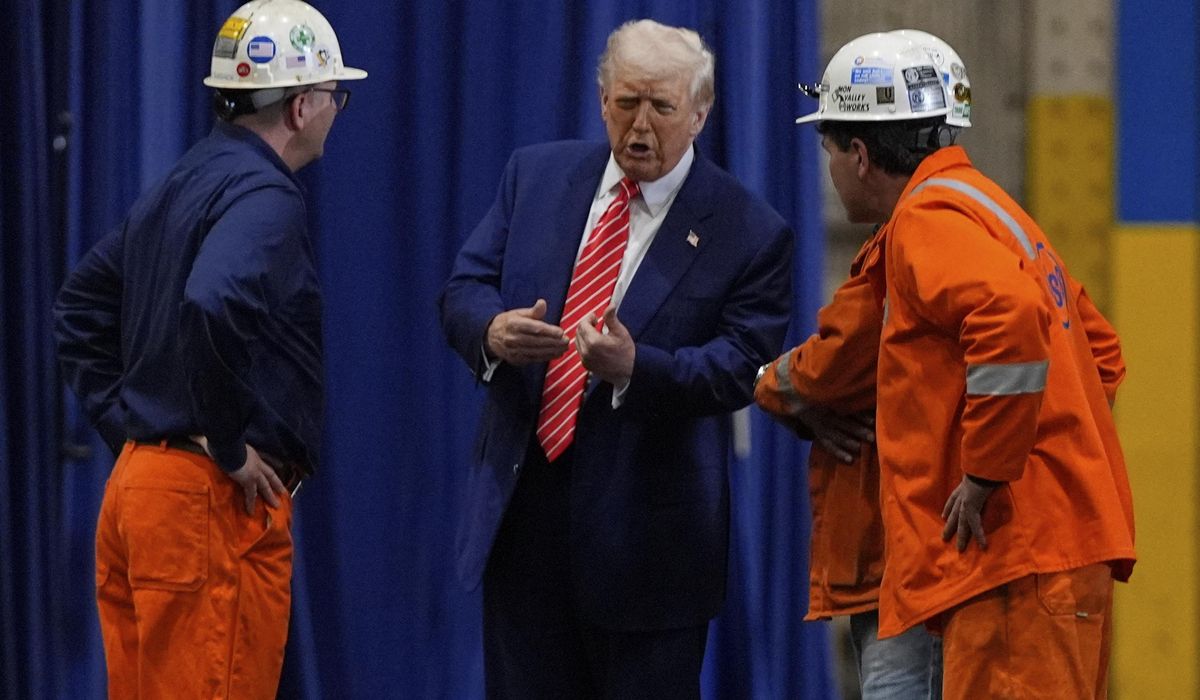


President Trump said he will double the tariffs he imposed on all steel imported into the United States to 50%, extending the trade battle he launched to protect American steel in March.
“We are going to be imposing a 25% increase. We’re going to bring it up from 25% to 50%, the tariffs on steel in the United States of America, which will even further secure the steel industry in the United States, nobody is going to get around that,” Mr. Trump said Friday during remarks at a U.S. Steel plant in West Mifflin, Pennsylvania.
Mr. Trump said he was considering a 40% tariff, but decided to raise it to 50%. He didn’t detail what led him to settle on the 50% number.
The announcement came during a speech celebrating the partnership between Japan’s Nippon Steel and U.S. Steel in which the Japanese-based company will pay roughly $13 billion for virtually all shares of its American counterpart.
In March, Mr. Trump announced he was levying a 25% tax on all imported steel and aluminum to help domestic steel and aluminum manufacturers. The move was an extension of steel tariffs Mr. Trump had imposed during his first term. Those tariffs were kept in place by President Biden.
Since the tariffs went into effect, U.S. employment in the fabricated metals sector has increased by 3,400 workers and primary metal manufacturing has grown by 2,600, according to Department of Labor data.
Raw steel production also increased, rising 6% since Mr. Trump took office. During the same period, capacity utilization in the steel industry, a key efficiency measure, increased by 3.7 points.
Those numbers have pushed steel manufacturers to plead with Mr. Trump to increase the steel tariffs beyond the initial 25%.
Mr. Trump made protecting the U.S. steel industry a critical part of his campaign message to save blue-collar jobs in Pennsylvania and other Rust Belt states such as Michigan, Indiana and Ohio. The president swept the Rust Belt states in the 2024 election.
Some organizations, such as the U.S. Chamber of Commerce, have opposed the tariffs, arguing that the steel and aluminum tariffs will result in higher costs for American manufacturers that they will pass along to consumers. That would make America less competitive with other nations, the Chamber has argued.
“Price hikes for industrial inputs like steel and aluminum hurt a broad swath of downstream manufacturers across the United States, from the auto and aerospace sectors to food producers and the oil and gas sector,” John G. Murphy, a senior vice president at the chamber, wrote in a recent blog post. “For every job in steel production, there are roughly 80 Americans employed by manufacturers that use steel as an input.”
Mr. Trump used the steel tariffs combined with higher tariffs on all imports from China to combat the flood of cheap overseas steel from countries where production is subsidized by those governments.
The moves have drawn high praise from the steel industry.
“President Trump is a champion of the domestic steel industry and his America First trade policy is designed to fight the unfair trade that has harmed American workers and weakened manufacturing in the United States,” said Steel Manufacturers Association President Philip K. Bell, adding that the steel tariffs will “turn America into a manufacturing powerhouse.”
The cost to manufacture steel in the U.S. is on par with or lower than that of many of the world’s top steel-producing nations. In 2021, it cost $707 per ton to make steel in the U.S., according to the most recent data from the Office of the U.S. Trade Representative. That’s the same price as China and below Japan ($855 per ton) and Germany ($905 per ton), two of the largest exporters to the U.S.
However, the governments of other countries subsidize steel production, reducing costs. Those subsidies and other trade barriers allow foreign countries to sell steel cheaper to American customers than U.S.-made steel.
In 2021, half the world’s top steel companies were state-owned, empowering them to sell their steel at prices below the cost of production. American steel companies would likely go bankrupt if they set prices below the cost of production.
China accounted for 53.9% of the world’s crude steel in 2023, according to data from the World Steel Association. Beijing’s steel subsidies are more than 10 times higher than those of other economically developed countries.
Six of the top 10 largest steel companies in the world are in China, and five of those are state-owned. The heavily subsidized steel industry allows China to undercut U.S. producers.
• Tom Howell Jr. contributed to this story.
• Jeff Mordock can be reached at jmordock@washingtontimes.com.
